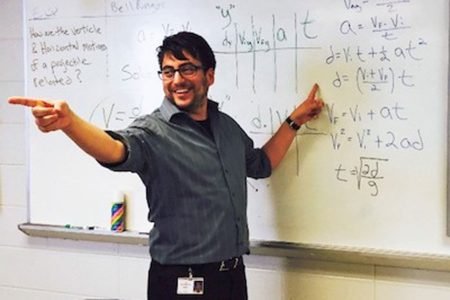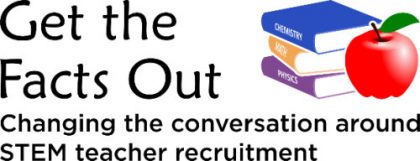Do college faculty members support grade 7-12 teaching?
 The United States is facing a critical shortage of grade 7-12 STEM teachers, especially in physics, chemistry, and math. This shortage will likely lead to snowballing effects: fewer STEM majors at the college level, fewer skilled workers in science and technology, and lower overall scientific literacy in the US population. So, what can we do about it? One place to start is with the perceptions and knowledge of college faculty members. Most college students look to faculty members for career advice. Are students encouraged to pursue teaching when they talk to their advisors? Or is this one of the critical points where young people are steered away from teaching?
The United States is facing a critical shortage of grade 7-12 STEM teachers, especially in physics, chemistry, and math. This shortage will likely lead to snowballing effects: fewer STEM majors at the college level, fewer skilled workers in science and technology, and lower overall scientific literacy in the US population. So, what can we do about it? One place to start is with the perceptions and knowledge of college faculty members. Most college students look to faculty members for career advice. Are students encouraged to pursue teaching when they talk to their advisors? Or is this one of the critical points where young people are steered away from teaching?
To provide insight into these important questions, and as part of the Get the Facts Out project, two surveys were developed to measure perceptions of teaching as a profession. We collected responses from over 2000 university students and over 500 university faculty members. Some of the questions focused on perceptions and facts about the career, while others focused on aspects of support and advising. We analyzed the data using a technique called Factor Analysis, which divided our questions into categories based on the responses we received. We can look at these categories as well as individual questions to get a sense of what faculty and students think of teaching careers and where their perceptions of the career (and support for it) might differ.
 Would you be proud to be a teacher?
Would you be proud to be a teacher?
One illuminating set of questions focused on pride: we asked students whether they would be proud to tell others that they were a grade 7-12 teacher, and we similarly asked faculty members whether they would be just as proud to tell people that they were a grade 7-12 teacher as they are to tell people that they are a college faculty member. Among students who also said they plan to become a teacher, an encouraging 81% said they would be proud to tell others. However, only 37% of faculty answered that they would be proud of such a profession. This disparity indicates a huge gap in how faculty members and future teachers view the profession. If we want faculty to truly encourage teaching, we should work on closing this gap by helping them see the value and pride in a teaching career.
What do students and faculty understand about grade 7-12 teaching?
In our analysis, a few categories within the surveys focused on facts about teaching. These included facts about retirement benefits, stability, salaries compared to other professions, and more. (For a complete list of questions and categories, visit the survey page on our website getthefactsout.org.) In the student survey, one fact-based category was named “Employee Benefits and Stability.” Students who wanted to become grade 7-12 teachers, on average, knew only about 25% of the information in this category, which is surprisingly low considering that they are going into the profession. For students who did not want to become teachers, the number was closer to an abysmal 15%. To be clear, both groups of students perceived the benefits and stability of teaching careers to be much worse than they actually are. Where do these negative perceptions come from? And how can we change them?

Results from our faculty-focused survey may provide some potential answers to these questions. In this survey, our analysis also resulted in fact-based categories, one of which we simply called “Facts About Teaching.” Similar to our results with students, most faculty members sorely underestimated the positive aspects of teaching careers. For example, when asked whether teaching pays a lot less than most other careers a student can get with the same degree, almost 62% of faculty said yes. However, this is a statement that is objectively not true. Starting teacher salaries are comparable to other STEM professions and mid-career teacher salaries typically range between $60,000 and $100,000.
Furthermore, 82% of faculty members underestimated teacher retention, and about 70% of faculty members underestimated retirement benefits for teachers. Overall, the faculty members who took our survey knew less than 40% of the correct facts about teaching careers on average. If faculty advisors don’t know the facts about teaching careers, it is likely that they will not be able to accurately advise their students about the profession.
“Misinformation is likely to be a major reason that students avoid teaching careers, leading us to the nationwide teacher shortage that we are seeing today.”
 Are students encouraged to pursue teaching?
Are students encouraged to pursue teaching?
Regarding advising and support for teaching careers, we again found some disparities between the perceptions of faculty members and students. One of our student survey statements was, “If I told my advisor I wanted to be a grade 7-12 teacher, s/he would encourage me.” About 71% of students agreed. While it’s encouraging that the majority of students agreed with the statement, it still means that almost 30% of students thought their advisor would not encourage them.
We also asked faculty members a series of analogous questions: whether they would be comfortable with their strongest student becoming a grade 7-12 teacher, going into industry, or going to graduate school. 81% of faculty claimed that they would be comfortable with their strongest student becoming a grade 7-12 teacher, which is 10% higher than student perceptions of their encouragement. On the other hand, 86% of faculty said they would be comfortable with their strongest student going into industry, and 96% of faculty members, almost all of our respondents, would be comfortable with their strongest student going to graduate school. Students are perceptive, and they can usually pick up on the subtle cues that their advisors give them. If advisors have a preference for their students going to graduate school, their students will probably notice it even if it’s never explicitly stated.
The point above is important for everyone who interacts with potential future teachers. If we want to solve the STEM teacher shortage in the US, and if we want young people to find the career that is truly best for them, we need to be genuine in our support and encouragement for teaching as a potential career option.
Teaching is a fulfilling, stable career that many students would excel in and enjoy, but they will be quick to turn away from it if we show a lack of support. Even worse, they will be discouraged and dissuaded if we share incorrect information about the benefits of the career.
Teachers rate their lives higher than almost all other occupation groups, including engineers and other professionals. Faculty members (and others in students’ lives) need to understand and internalize this fact, so that we can all express genuine excitement and encouragement when a student conveys interest in grade 7-12 teaching.
What can we do to support future teachers?
Many of us have roles in the lives of younger people, whether we are college faculty members, parents, co-workers, or friends. Based on the data above, there are two major things that faculty members and others need to do in order to fully support and encourage teaching careers.
- Understand the facts about teaching and develop a respect for the profession.
- Offer genuine support to those who are considering teaching as a career.
If someone you knew told you that they wanted to become a teacher, what would your first reaction be? Excitement? Pride? Or would you hesitate, or even discourage them from making that choice? We all have an effect on the people around us, and faculty members have an especially strong impact on their students. We should all make sure that we are informed about the teaching profession so that we can earnestly support those who are interested. If you want to learn more about what a career in 7-12 teaching is actually like, or if you want materials that could assist you in offering genuine support to teaching interested students, visit our resources page on our website at getthefactsout.org/resources.




